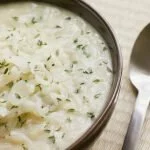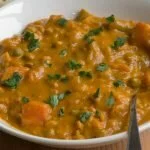British Recipes
British Cider and Onion Soup
We all know that French onion soup is something that probably can’t be beaten or improved on. So you have the beef stock, the onions, white wine, Gruyere, croutons… doesn’t it make your mouth water just to think about it? However, what you might not know is that the Brits have their own version of French onion soup – an onion soup made with cider instead of white wine and which is white or off-white in colour. In the UK cider is always alcoholic, what the Americans call hard cider. If it’s non-alcoholic they simply say apple juice. British cider is flat or sparkling. Any type is fine for making this recipe.
In addition to the cider we are using butter, leeks, onions, apples, potatoes, stock and herbs. Thyme and bay leaves are used to flavour the soup but they are discarded before serving. We like to add Gruyere cheese, thyme and sometimes a little ground nutmeg for garnish. The Gruyere and thyme are ingredients ‘borrowed’ from the typical French onion soup recipe but they go so well with the onions, so be generous with them here!
This soup would be nice for lunch or dinner, or you could serve half-sized portions as a starter recipe. A lot of the alcohol will be ‘cooked off’ but if you really don’t want to use it then simply sub the hard cider for regular cider or apple juice. The recipe will still taste nice. Served with some crusty white bread, this makes a great meal and there is something so satisfying about the combination of flavours. Try it for yourself and see! Continue reading
Bubble and Squeak Cakes
This tasty English recipe is traditionally made with mashed potatoes and vegetables left over from the Sunday roast dinner. The main ingredients are of course potatoes and vegetables, and you can use any vegetables you wish, with carrots, Brussels sprouts, cabbage, and peas being typical ones. These ingredients are combined with some fried onion (this is optional but we love to add onion to ours for extra flavour) and salt and black pepper for an easy side dish. The next time you make a roast dinner, make sure you cook enough to have leftovers, because this is well worth making, I promise you!
We often don’t seem to have leftovers because my husband and I appreciate great food and we have 4 growing boys who seem to be hungry most of the time. So even when I cook ‘enough to feed an army’ the food seems to vanish quickly! However, it’s worth making extra so you can make bubble and squeak. Failing that, you don’t have to use leftovers. You can cook mashed potatoes and veggies just so you can make this yummy side dish.
Some people make one big one and then cut it into wedges but I like to make individual cakes. Dip them in flour before frying so you get a nice crust on them and they can be flipped without breaking into pieces. This was a popular recipe during World War II because it was a simple way of converting leftovers into something yummy when most foods were of course subject to rationing. Try them with ketchup. One of my English friends says she likes to serve these with bacon and fried eggs at breakfast time. Continue reading
British Pub Style Vegetable Curry
British curry? Don’t you mean Indian curry or Thai curry? Nope, this recipe is for British curry, the sweet, thick kind you get from pubs all over the UK. Yes the Brits got the idea from India but they have adapted the flavours to their own palates, which is why British curries tend to be thick, sweet and not too spicy. In a British pub you can order curry with a jacket potato (baked potato), rice or chips (fries) or even half rice and half chips in many places. Expect a mild flavour, but you can ask for hot sauce if you want to liven it up a bit. British pub curries usually tend to be chicken, beef or vegetarian.
In the following recipe we are using potato, carrot, onion, bell peppers, and pineapple as the main ingredients, adding some sultanas or raisins too, and some peas or corn (or both) and coconut milk or cream. Add mild curry powder for flavour, and some salt and black pepper. It is important to simmer this curry very gently because that’s when the flavours blend nicely. Enjoy the delicious exotic smells in the kitchen while this cooks!
Change any ingredients you want, perhaps swapping the potato for an extra carrot or some button mushrooms or spinach. Some people like to add some cashews when they add the peas/corn, while others add a little hot sauce. Get creative with it and have some fun! This curry has potato in it so you might want to serve it by itself instead of with a potato side dish. If you don’t mind some extra carbs though, white rice or naan bread goes well. Head to any High Street in Britain and the odds are high you will find at least one curry house. Indian chefs who had immigrated into the UK started preparing lighter, milder curries in the 1970s, for the British palate, and today a high percentage of Brits enjoy curry at least once a week! Continue reading
Rustic Oat-Crusted Herring
If you’re looking for hearty peasant food rather than something elegant, consider this tasty Scottish recipe. Small fish such as herring or sardines are perfect for making this dish, or you could even try mackerel, croakers, dabs or similar. If you make friends with your local fishmonger, perhaps he will remove the bones for you. If you have to do it yourself, cut along the underside and hit the backbone a few times. Next, pull the backbone out along with as many of the bones as you can. Now scrape the scales off using a knife, and discard the heads and tails. It’s easy to fillet herrings, I promise you!
The flavour is really nice, and you will find the mustard cuts through the richness of the fish. The oats make me think of cosy autumn or winter. The traditional Scottish way of serving oat-crusted herring is mashed or boiled potatoes or thick slices of bread and butter, although modern cookbooks featuring this recipe suggest lemon and parsley, or even crispy bacon (yum, we like that idea!)
My family loves creamy mashed potatoes on the side, and plenty of them, but sometimes bread and butter is good too. You don’t need many ingredients for this tasty Scottish recipe so you can rustle it up quickly when you want something hot and tasty to eat for lunch or dinner. The herring fillets are covered in salt then soaked in a creamy mustard mixture. They are then coated in oats and pan-fried until crispy. Herring and oats are both Scottish staples, so it makes sense to combine them and make this wonderful rustic dish. Give it a try and see how it compares to your family’s usual crispy fish dinner. I bet you’re going to love it! This recipe serves 2 people but it’s easy to make more if you’re feeding a crowd. Continue reading
Broccoli and Stilton Soup
This rich and creamy soup is perfect for any occasion. Try it as a snack on a chilly afternoon, have a small portion of it before a meat-based dinner or try it on your family so they can appreciate your soup-making abilities! You don’t have to use Stilton here but if you can get some of that amazing English blue cheese it’s totally worth it. Stilton is amazing! If not, then try another kind of blue cheese and the recipe will come out similar. As well as the broccoli and cheese, you are going to need leek, potato, celery, butter, and stock to make this , so you can imagine the end results – a creamy, rich-tasting soup.
After cooking the onions you will be adding the leek, celery and potato along with some butter. Next you add the broccoli and then you can puree the soup in the blender. After this, add the Stilton or whatever blue cheese you decide to use. Don’t worry about lumps where the cheese doesn’t quite dissolve, because those are fine in this soup. This thick, rich soup is great served with crusty white bread to mop up absolutely every drop.
Stilton cheese is English and it comes in 2 varieties – blue and white – although the white is largely unknown (even in England). Stilton is produced in England, in Derbyshire, Nottinghamshire and Leicestershire. Legend has it that Cooper Thornhill, a cheese seller, discovered Stilton in 1730 while visiting a farm close to Melton Mowbray in Leicestershire. He loved it right away and began to sell it. The rest is history and this cheese has been popular ever since. In order to be officially known as Stilton, a cheese must have its own coat or crust, not be pressed, have a ‘Stilton’ flavour, have blue veins coming out from the centre, have a fat content of about 35%, and have at least 48% milk fat content in the dry matter. Continue reading
- Sea Perch with Apple-Cranberry Chutney May 28, 2016
- Creamy Colcannon with Irish Cheddar May 21, 2016
- Ultimate British Chip Butty May 9, 2016
- Tasty Welsh Rarebit Recipe May 1, 2016
- Authentic Devon Scones April 24, 2016
- British Cider and Onion Soup April 23, 2016
- Bubble and Squeak Cakes April 17, 2016
- British Pub Style Vegetable Curry April 16, 2016
- Rustic Oat-Crusted Herring April 15, 2016
- Broccoli and Stilton Soup April 14, 2016
- Lemon and Garlic Chicken Bake April 13, 2016
- Queen of Puddings April 11, 2016
- Queen Victoria’s Brown Windsor Soup April 10, 2016
- Roasted Topside of Beef April 7, 2016
- Scottish Smoked Salmon with Lemon Dressing April 6, 2016
- How To Make Stuffed New Potato Canapés (107383 Views)
- Easy Toffee Recipe (4739 Views)
- Cheese and Asparagus Tartlets (2986 Views)
- Scottish Smoked Salmon with Lemon Dressing (2983 Views)
- The Best Dessert Chefs in Britain (2745 Views)
- Battenberg Cake Recipe (2217 Views)
- TeaTime (2007 Views)
- How to Serve Traditional English Cream Tea (1552 Views)
- How to Brew Earl Grey Tea (1450 Views)
- Tea Party Table Setting Ideas (1272 Views)
- About
- Contact
- Medical Disclaimer
- Privacy Policy
- Recipe Publishing Network
- Sitemap
- TeaTime
- TeaTime Recipes
- Terms of Use







